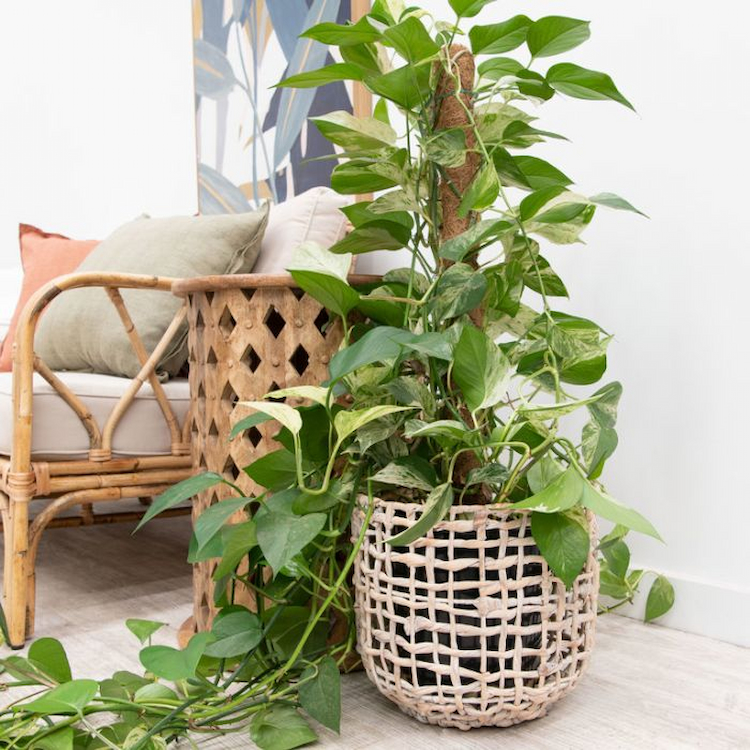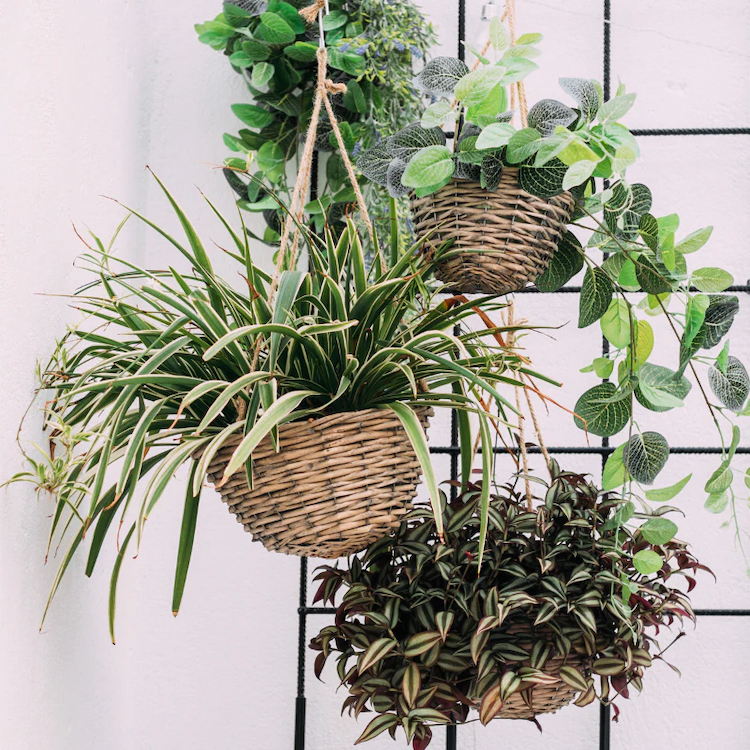Decorating with indoor plants is one of the best ways to enhance a room’s aesthetics. They have the power to transform the space, bring colours, freshness and a sense of calm. But placing them on the windowsill is sometimes not enough. If you want to make them stand out, you should arrange them with care and purpose.
Woven Baskets

source: flowerpower.com.au
Using natural materials is one of the simplest, most beautiful and most effective ways of accentuating indoor plants. Baskets made from rattan, wicker, seagrass, or dried straw bring a warm, earthy feel to your home. They also add depth and texture into the space. Compared to plain, ordinary pots, baskets can complement a wide variety of interior designs, from modern minimalism to rustic and boho décor.
Choosing a beautiful, decorative basket for plants is not a complicated task. If you’re a fan of tall leafy plants like monstera, fiddle leaf fig, or snake plants, go for a larger basket. It anchors the plant and gives it a strong presence in the room. Smaller plants, like succulents or ferns, can be settled in smaller holders and placed on side tables or shelves. They can act as small pops of greenery all over the place.
You can also use the plant baskets to hide some older or not-so-aesthetically-pleasing pots. Make sure you protect them from water damage because usually these natural materials aren’t waterproof. Lining the basket with a waterproof liner or a plastic pot is a good idea. This way you can water the plants without the worry of damaging the baskets. If you don’t want to shop separately, there are baskets that come with built-in liners.
Mixing and matching styles of basket for plants can also create an appealing layered effect. Combine tall, narrow baskets with shorter, wider ones, or pair different weaves and shades of rattan for a more dynamic display. This is a very good idea especially when you’re grouping different types of plants in one room.
Overall, these woven baskets made of natural materials are more than just holders for your indoor plants. They’re also a wonderful way of enhancing the plants’ beauty, adding more texture to the space, and creating a warm, cosy and inviting atmosphere. With a little thought and creativity, these baskets can transform your indoor greenery into a stylish focal point.
Shelves
If you want to create a lush and layered look, using shelves and tiered stands is a great way to do it. They can help you showcase your indoor plants in a special way. Floating shelves, bookcases, or dedicated plant stands allow you to display plants at different heights, giving a sense of depth and visual interest to any room.
For a more dynamic display, add plants with different sizes and shapes. Combining a trailing pothos or ivy with an upright snake plant can help you create a contrast in form and height. Adding a mix of decorative items like small sculptures, candles or picture frames can add to the whole charm.
Placing plants at different heights maximises natural light. Taller plants can go on the lower shelves and shorter ones can go on top. Shelves are also a good way to save floor space, especially if you live in a small house. Using vertical space can give you structure and flexibility. Plus, you can rotate the plants for a fresh look.
Hanging Planters

source: pinterest.com
As a complement to shelves, hanging planters are also good for freeing flooring space. Macramé hangers, ceramic pots suspended by rope, or even glass globe planters can turn any corner into a mini, indoor jungle. Macramé hangers, in particular, add texture and a boho touch, complementing natural and neutral interiors beautifully.
Just make sure the hooks on the walls or ceilings are secured properly so there won’t be any accidents. You can also use a basket for plants to complement the whole setting. If you were wondering which plants are most suitable for hanging planters, the answer is trailing plants such as pothos, spider plants or string-of-pearls.
They trail down beautifully, creating a flow and a fun movement, which adds visual interest. For a more delicate and airy feeling, you can add smaller plants like ivy and ferns. Hanging plants usually get enough sunlight when placed near a window. You can also hang them in a corner and add a sense of depth.
Statement Colours
Sometimes, the most successful way of accentuating the beauty of your plants is with colour. Bright and vibrant pot colours can make a statement. Even patterns and unique shapes can make the plant a focal point of the room. Mixing textures also adds interest. Smooth ceramic pots and leafy plants, or a plant basket with plants with shiny leaves are a great combination.
You can colour-coordinate pots with the colour palette in the room and create a cohesive look. Size is also important. Large plants need larger pots and vice versa. By carefully selecting pots that suit both the plant and the room, you can turn even the simplest plant into a design feature.
Grouping and Layering
Grouping plants together is an easy way to create a lush, eye-catching display. By combining different shapes, sizes and textures, you create a visually appealing arrangement that can elevate the room’s aesthetics. Layering also works on tables, shelves and windowsills.
Taller plants go in the back, medium in the middle, and the smallest at the front. This approach creates depth and makes your display feel intentional and full rather than random. For a final touch, you can mix in some decorative objects like a small stack of books, sculptures or candles to add some charm.

